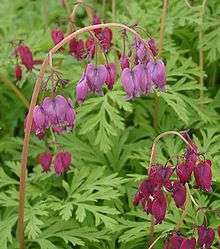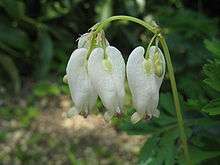Dicentra formosa
| Dicentra formosa | |
|---|---|
| | |
| Scientific classification | |
| Kingdom: | Plantae |
| (unranked): | Angiosperms |
| (unranked): | Eudicots |
| Order: | Ranunculales |
| Family: | Papaveraceae |
| Subfamily: | Fumarioideae |
| Tribe: | Fumarieae |
| Genus: | Dicentra |
| Species: | D. formosa |
| Binomial name | |
| Dicentra formosa (Haw.) Walp. | |
Dicentra formosa (western, wild or Pacific bleeding heart) is a flowering plant with fern-like leaves and an inflorescence of drooping pink, purple, yellow or cream flowers native to the Pacific Coast of North America.[1][2][3]
Description
Pacific bleeding-heart is a perennial herbaceous plant. Its leaves are three to four times divided and fern-like, growing from a brittle rhizome at the base of the plant. It grows to 18 in (45 cm) tall by 24 in (60 cm) wide.[4][5][6][7]
The flowers are pink, red, or white and heart-shaped and bloom in clusters of 5 to 15 at the top of leafless, fleshy stems above the leaves from mid-spring to autumn, with peak flowering in spring. The four petals are attached at the base. The two outer petals form a pouch at the base and curve outwards at the tips. The two inner petals are perpendicular to the outer petals and connected at the tip.[4][5] There are two tiny, pointed sepals behind the petals. Seeds are borne in plump, pointed pods. The plant self-seeds readily. It frequently goes dormant for the summer after flowering, emerging and flowering again in autumn.
The Pacific bleeding-heart is frequently confused with the fringed bleeding-heart (Dicentra eximia)[8] and sold under that name. The fringed bleeding-heart has narrower flowers and longer, more curved outer petal tips. D. formosa is related to Lamprocapnos spectabilis, another popular plant called "bleeding heart", which was formerly placed in the same genus.
- Flowers and leaves
 Flower shape: Dicentra 'Luxuriant' (a Dicentra formosa hybrid) compared with Dicentra eximia
Flower shape: Dicentra 'Luxuriant' (a Dicentra formosa hybrid) compared with Dicentra eximia Flower cluster
Flower cluster Closeup of flower
Closeup of flower Leaves unfurling from a bud
Leaves unfurling from a bud
Ecology
The Pacific bleeding-heart is native to moist woodland, forest, and streambanks from California to British Columbia, from sea level to the subalpine zone.[4][5]
There are two subspecies, Dicentra formosa subsp. formosa and Dicentra formosa subsp. oregona. Subsp. formosa grows in the majority of the plant's range, from Vancouver Island and southern British Columbia and south through Washington and Oregon to central California in the Coast Ranges and Cascades, and on the western slope of the Sierra Nevada. Subsp. oregana grows in a small area of southern Oregon and northern California in serpentine soils in the Siskiyou Mountains. These subspecies are also distinguished by appearance:
- Dicentra formosa subsp. formosa — leaves glaucous beneath and never glaucous above, flowers purple pink to pink or white
- Dicentra formosa subsp. oregona (often spelled oregana) — leaves glaucous above and beneath, flowers cream or pale yellow
- A colony of plants

Cultivars

Dicentra formosa is widely grown as a garden plant, and several cultivars have been developed.[9] Those marked agm have gained the Royal Horticultural Society's Award of Garden Merit:
- white and green flowers
- 'Langtrees' (= 'Pearl Drops') — bluish-green leaves
- 'Margaret Fish' — bluish-gray-green
- 'Quicksilver' — bluish-gray-green — resentful of hot, humid climates and sun
- 'Snowflakes' (= 'Fusd') — green
- 'Sweetheart' — green
- pink and red flowers

There are several hybrid cultivars involving D. formosa, the eastern American species D. eximia and the Japanese species D. peregrina:[9]
- 'Adrian Bloom' (from a seedling of D. 'Bountiful') — dark pink flowers, bluish-green leaves
- 'Aurora' (D. formosa × D. eximia) — pure white, gray-green — particularly tolerant of hot-humid climates
- 'Bountiful' (D. formosa subsp. oregana × D. eximia) — rosy red, bluish-green
- 'Gothenburg' (D. formosa subsp. oregana × D. peregrina f. alba) — light pink, compact
- 'King of Hearts' — D. peregrina × (D. formosa subsp. oregana × D. eximia) — pink, bluish-gray-green
- 'Silversmith' (D. formosa subsp. oregana × D. eximia) — white pink-tinted, green
- 'Stuart Boothman' agm[12] (D. formosa subsp. oregana × D. eximia) — deep pink, gray-green
History
The Pacific bleeding-heart (Dicentra formosa subsp. formosa) was discovered by the Scottish surgeon and naturalist Archibald Menzies on the Vancouver Expedition. Menzies collected seed in 1792 in Nootka Sound, and gave it to the Royal Botanic Gardens at Kew in 1795. From there, seed made its way into cultivation in Europe. It apparently was not cultivated in the United States until 1835, when William Kenrick began selling the plant in Boston. The subspecies oregana was first cultivated around 1932, when it was offered by Borsch and Sons in Oregon, but is not grown very often.[9]
References
- ↑ Sullivan, Steven. K. (2015). "Dicentra formosa". Wildflower Search. Retrieved 2015-04-23.
- ↑ "Dicentra formosa". PLANTS Database. United States Department of Agriculture; Natural Resources Conservation Service. 2015. Retrieved 2015-04-23.
- ↑ Sierra Nevada Wildflowers, Karen Wiese, 2nd Ed., 2013, p. 83
- 1 2 3 Klinkenberg, Brian (Editor) (2014). "Dicentra formosa". E-Flora BC: Electronic Atlas of the Plants of British Columbia [eflora.bc.ca]. Lab for Advanced Spatial Analysis, Department of Geography, University of British Columbia, Vancouver. Retrieved 2015-04-23.
- 1 2 3 Giblin, David (Editor) (2015). "Dicentra formosa". WTU Herbarium Image Collection. Burke Museum, University of Washington. Retrieved 2015-04-23.
- ↑ "Dicentra formosa". Jepson eFlora: Taxon page. Jepson Herbarium; University of California, Berkeley. 2015. Retrieved 2015-04-23.
- ↑ RHS A-Z encyclopedia of garden plants. United Kingdom: Dorling Kindersley. 2008. p. 1136. ISBN 1405332964.
- ↑ Tebbitt, Mark; Lidén, Magnus; Zetterlund, Henrik (2008). Bleeding hearts, Corydalis, and their relatives. Timber Press. pp. 61–63. ISBN 9780881928822.
- 1 2 3 Tebbitt, Mark; Lidén, Magnus; Zetterlund, Henrik (2008). Bleeding hearts, Corydalis, and their relatives. Timber Press. pp. 63–66. ISBN 9780881928822.
- ↑ "RHS Plant Selector Dicentra formosa 'Bacchanal' AGM / RHS Gardening". Apps.rhs.org.uk. Retrieved 2012-10-21.
- ↑ "RHS Plant Selector Dicentra 'Luxuriant' AGM / RHS Gardening". Apps.rhs.org.uk. Retrieved 2012-10-21.
- ↑ "RHS Plant Selector Dicentra 'Stuart Boothman' AGM / RHS Gardening". Apps.rhs.org.uk. Retrieved 2012-10-21.
External links
| Wikimedia Commons has media related to Dicentra formosa. |
| Wikispecies has information related to: Dicentra formosa |
- Germplasm Resources Information Network page
- Jepson Manual Treatment
- USDA PLANTS profile
- Flora of North America
- CalPhotos (UC Berkeley photo gallery)
- King County Native Plant Guide
- IPNI Listing
- Kew Plant List